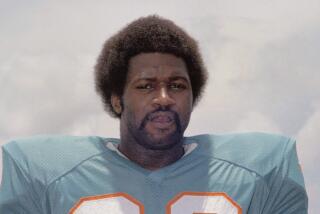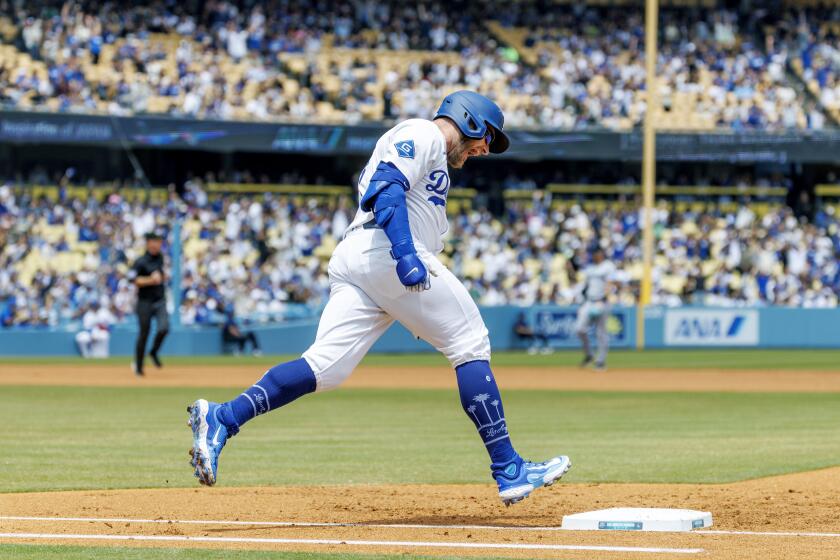Not Perfect Enough : Twenty Years Ago, the Dolphins Were on Their Way to the NFL’s Only Unbeaten Season--but They Still Aren’t Considered the Best Team Ever
- Share via
They didn’t realize it at the time, but the play of the year for the 1972 Miami Dolphins occurred during the third of their 17 games.
They were losing at Metropolitan Stadium in Minnesota, in the old outdoor home of the team that made four Super Bowl appearances during that decade. Quarterback Bob Griese called a play-action pass with 1 minute 20 seconds to play and faked a handoff to fullback Larry Csonka.
“Csonka was bigger than all but two or three of (Minnesota’s) Purple People Eaters,” Jim Mandich, a Miami tight end that year, recalled recently. “Here we are on their four-yard line--and here comes a 260-pound fullback. It didn’t surprise me that about 10 of those People Eaters went for Csonka.”
The 11th, Jim Marshall, the Vikings’ all-pro defensive end, went for Mandich.
“If it’s a play-action pass, it’s my play, maybe, and Marshall knows it,” Mandich said. “So he knocked the daylights out of me, and left me lying there. Then he went for Csonka, too.
“(Griese) knew where I was supposed to be, and he threw the ball there. I scrambled up off the ground just in time to catch it.”
Mandich scored and the Dolphins won, 16-14. Never again did that 1972 team face imminent defeat.
They played 14 regular-season games, plus three playoff games, and won all 17--ending a perfect season in the Super Bowl.
“Game after game, everything just came together for us,” Coach Don Shula said recently from Miami.
This is the 20th anniversary season of Shula’s perfect year, the only one in NFL history.
In 73 NFL regular seasons, only two other teams have won all of their games--but both were beaten in championship play.
In 1934, the Chicago Bears (13-0) lost the title game in New York to the 11-3 Giants, 30-13. In 1942, the Bears (11-0) lost to the Redskins (10-1), in Washington, 14-6.
“The old-timers were talking about that before (Super Bowl VII),” Shula said of the week before the Redskin-Dolphin title game in Los Angeles on Jan. 14, 1973.
During a 14-7 victory at the Coliseum--Shula’s first Super Bowl victory after a string of championship-game defeats--the Dolphins shut out Washington until the last two minutes, when Miami botched a field-goal attempt. Miami’s kicker, Garo Yepremian, deciding to throw the ball, did so to Redskin back Mike Bass, who returned it 49 yards for a touchdown.
Yepremian’s pass was only one of the unforeseen things that happened to the 1972 Dolphins. No one expected the Dolphins to keep winning after Griese suffered a broken leg during their fifth game.
Griese sat out 11 of the 17 games. But the Dolphins won all 11 with 38-year-old backup quarterback Earl Morrall, then in his 17th NFL season.
Shula had brought Morrall in from Baltimore--where Shula had coached--shortly before the 1972 season began after the owner of the Colts, Carroll Rosenbloom, decided to cut Morrall.
“John Unitas and I are the same age,” Morrall said. “And C.R. told me: ‘One 38-year-old quarterback is enough.’ ”
And one 38-year-old quarterback proved to be all that the Dolphins needed.
“Against the New York Jets, I went 31 yards on my longest scramble,” Morrall said. “There were two 1,000-yard rushers on our team (Csonka and Mercury Morris), but my 31-yard touchdown was the longest by a (Dolphin) all year.”
Longest and, of course, the most unexpected.
FLAWED PERFECTION
Stranger than Morrall’s story is what has happened to the Dolphins’ perfect 1972 team since.
In the all-time polls, they have yet to finish No. 1.
Nobody calls them the greatest in football history.
Nobody, that is, but the Dolphins.
They have found that it was easier to win all of their games than to win over their critics.
Most still rate the 1972 Dolphins behind the best of the 1970s Steelers with Terry Bradshaw and the best of the 1980s 49ers with Joe Montana, among other teams.
“That’s crazy,” Shula said. “How can anyone be better than perfect? I don’t know how any team can be rated over us. The (1972 Dolphins) had to be the best ever, not just because we were 17-0, but the way we played.”
His senior assistant, Carl Taseff, Shula’s 1940s college roommate, likes to talk about how they played.
“The other great teams in this (century) all left themselves in position to be (beaten or tied) at least once,” Taseff said. “(In 1972), we stayed out of that kind of trouble. The thing that makes us (No. 1) is that we kept control. You couldn’t beat us.”
That’s the most telling of the pro-Miami arguments.
As Shula said: “The thing I remember most about that year is that when we got the ball on our first series, we would take it six, seven, eight minutes and march it 70, 80, 90 yards and have seven points on the board.”
No 80-yard pass plays, but 80-yard drives.
They didn’t dominate the way some teams have, but, as Taseff said, “You couldn’t beat us.”
And, Shula asked, “Isn’t that the bottom line?”
If the perception lingers that the 1972 Dolphins were nothing but a Csonka power company, that’s wrong, too, the players insist.
For one thing, they probably weren’t going to win the AFC title game without a run by their punter, Larry Seiple, setting up a touchdown that beat the Steelers, 21-17.
“It wasn’t spur of the moment,” said Seiple, who coaches Dolphin receivers now. “We worked on it all week.”
That’s Shula.
It is often said that if Shula’s 1972 team can’t be ranked as the best ever, “his coaching job can,” as Steve Sabol says.
Sabol is the president of NFL Films, the organization that used computers four years ago to identify the 1978 Steelers as No. 1, with the 1972 Dolphins No. 2.
“We polled 26 coaches, and got 21 votes for the (1978 Steelers),” he said. “The others in the (semifinals) were the 1976 Raiders and 1984 49ers.”
Pittsburgh edged Miami in the computer Super Bowl, 21-20, when Franco Harris scored on a draw play with three seconds to play.
“The ’78 Steelers were the best-ever team,” Sabol said. “Shula in ’72 was the best-ever coach.”
Why did 21 of 26 other coaches vote down his team?
Here are some of the reasons:
--To this day, the ’72 Dolphins have contributed only four Hall of Famers--Paul Warfield, Csonka, Griese and Jim Langer--none of them members of their perfectly named No-Name defense.
--After winning 16 consecutive games, the Dolphins were still underdogs against Washington in Super Bowl VII.
--Offensively, they were so unimpressive in the Super Bowl that a defensive player, Jake Scott, was voted most valuable player.
--But Miami’s 1972 defense wasn’t very explosive, either. It presented no Lawrence Taylor, no Deacon Jones, no Howie Long. Basically, the No-Name unit was the perfect creation of defensive coach, Bill Arnsparger, now with the San Diego Chargers.
After 20 years, the Arnsparger era in Miami is remembered not for a defensive star, but for a number. The number was 53, the defensive changeup call that altered their 4-3 front to 3-4. Or vice versa.
Numbers can make you perfect, perhaps, but not famous.
THE WORRIERS
Will there ever be another perfect pro club?
“Somebody might do it,” Shula said. “I suppose it’s possible.”
Said quarterback Morrall: “I wouldn’t bet on it. The NFL is into parity these days, and they’ve got a 19-game season now, counting the Super Bowl. That’s a long, long time to keep it together.”
Morrall has been one of the most successful of the NFL’s old pros. Although the 1972 Dolphins have produced a firefighter, an attorney or two and anesthesiologist Doug Swift, along with several successful businessmen, Morrall seems to be having the most fun.
At 58, he can play golf free of charge all day, if he chooses, because he owns the country club at Davie, Fla.
He was also the mayor of Davie, population 50,000, until resigning last month to run for the state legislature.
“Perfection is the one thing we have going for us,” Morrall said. “The longer we’re the only perfect team, the longer we can (hold fan) interest.”
That bugs Larry Little, the 1972 Dolphins’ right guard and their best lineman on either side of the ball.
“We couldn’t have done what we did without great talent,” he said.
The team that had few worries in 1972 worried mightily when the 1984 49ers (18-1) started 6-0 and when the 1985 Bears (18-1) started 12-0.
Again last year, when the Redskins were on an 11-game winning streak, the old Dolphins grew more nervous by the week until the Dallas Cowboys won in Washington, 24-21.
That got a celebration going in the Miami neighborhood shared by Griese and two 1972 teammates, linebacker Nick Buoniconti and safety Dick Anderson.
Said Anderson: “As soon as Dallas kicked that winning field goal, I called up Nick and said I was coming down the street with a bottle of champagne.”
Morrall, whose 21-year NFL career has been exceeded only by George Blanda’s of 26, celebrated more quietly.
“I called up everyone I know,” he said. “And told them, ‘We did it again.’ ”
Where Are They Now?
A look at the leading players from the 1972 Miami Dolphin team, with position, age, residence and occupation:
THE CSONKA POWER CO. Paul Warfield (WR), 49, Moraine, Ohio. Runs employment agency. Marv Fleming (TE), 50, Marina del Rey. Sports agent. Wayne Moore (LT), died at 44. Former football coach. Bob Kuechenberg (LG), 44, Miami Lakes. Advertising. Jim Langer (C), 44, Brainerd, Minn. Banker, farmer. Larry Little (RG), 46, Columbus, Ohio. Football coach.* Norm Evans (RE), 49, Issaquah, Wash. Runs role-model seminars. Jim Mandich (TE), 45, Miami. Radio sports commentator. Howard Twilley (WR), 48, Tulsa, Okla. Retired shoe store owner.* Bob Griese (QB), 47, Miami. TV football announcer. Earl Morrall (QB), 58, Davie, Fla. Owns country club. Jim Kiick (HB), 46, Ft. Lauderdale, Fla. Public defender’s investigator. Mercury Morris (HB), 45, Miami. Motivational speaker. Larry Csonka (FB), 45, Lisbon, Ohio. Motivational speaker. Garo Yepremian (K), 48, Lancaster, Pa. TV talk-show host.
THE NO-NAME DEFENSE Vern Den Herder (LE), 43, Sioux City, Iowa. Farmer.* Manny Fernandez (LT), 46, Miami. Mortgage business. Bob Heinz (RT), 45, unknown. Former businessman, Palo Alto.* Bill Stanfill (RE), 45, Albany, Ga. Owns motel, restaurant. Doug Swift (LLB), 43, Philadelphia. Anesthesiologist. Nick Buoniconti (MLB), 51, Coral Gables, Fla. Lawyer, TV announcer. Mike Kolen (RLB), 44, Opelika, Ala. Owns physical-fitness center. Bob Matheson (LLB), 47, unknown. Former college coach.* Tim Foley (LCB), 44, Taveres, Fla. Owns home-products firm. Curtis Johnson (RCB), 44, Toledo, Ohio. Firefighter. Jake Scott (FS), 47, Hawaii. Investor* Dick Anderson (SS), 46, Miami. Owns car-phone business. Larry Seiple (P), 47, Miami. Coaches Dolphin receivers. * --Researchers for the Dolphins, the Miami Herald and other Florida organizations are unsure of exact status.
More to Read
Go beyond the scoreboard
Get the latest on L.A.'s teams in the daily Sports Report newsletter.
You may occasionally receive promotional content from the Los Angeles Times.










